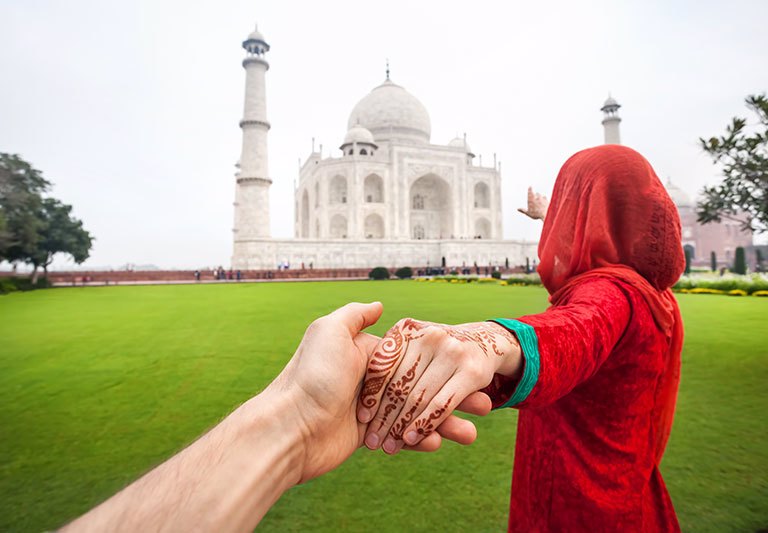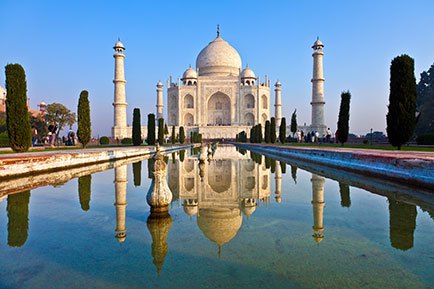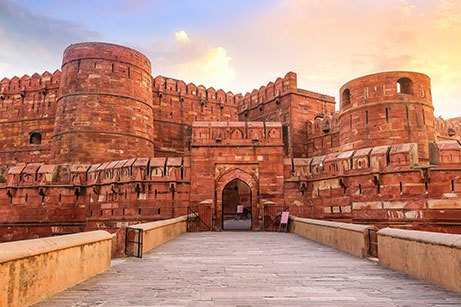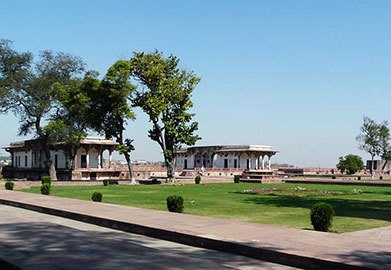Read. Imagine. Travel.
Namaste! As we have been taking you on incredible sojourns in the Indian sub-continent, we would like to thank you for invaluable insights and support for the TravNama, our special way of keeping in touch with you. We appreciate your enthusiasm on discovering the exquisite destinations and their unique experiences with us. It is always a delight for us to highlight the ever-beautiful spots of the Indian Sub-Continent for your esteemed clients.
In this edition, we will take you to explore “The city of love – Agra”. Settled in the heart of Uttar Pradesh, on the banks of river Yamuna, Agra is a slow-paced and quiet town. Also known as the city of the Taj Mahal, one of the Seven Wonders of the World, Agra’s significance as the political center of the Mughal Empire ended when Mughal Emperor Shah Jahan shifted his capital to Delhi. However, Agra’s architectural legacy has found it a place in the pages of history. Discover Taj Mahal, the epitome of timeless love in this short video.

The architectural splendor of the fort, mausoleums and palaces here are a reminder of the opulence and artistic taste of the Mughal Empire. Agra is also famous for its superb inlay work on marble and soapstone by artisans, who are the descendants of those who worked under the Mughals.
Here are some of the best things to do in Agra:
1. Feel the love at Taj Mahal

Taj Mahal, popularly known as Crown of Palaces and an Epitome of Love, is a white marble mausoleum and a UNESCO World Heritage Site. As a testament to his love, the magnificent structure was built by Mughal Emperor Shah Jahan in the loving memory of his beloved wife, Mumtaz Mahal. Commissioned in 1632, it took approximately 22 years in the making of this marvelous structure and an estimated 20,000 workers to build this masterpiece that reflects different colors under the canopy of sun. The relief work in marble and inlay with precious and semi-precious stones sets it apart from other monuments. Purely ecstatic and iconic, it attracts 7 to 8 million visitors annually. Taj Mahal is virtually the same from all the four sides and is endorsed as "The Jewel of Muslim Art in India".
2. Visit “India’s First Red Fort” - Agra Fort

The great Mughal Emperor, Akbar, approved the development of the Agra Fort, although there were additions made till the time of his grandson, Shah Jahan. There are many fairy-tale palaces like Jahangir's Palace, Khaas Mahal and Sheesh Mahal; audience halls Diwan-i-Aam, Diwan-i-Khaas; beautiful mosque Moti Masjid - a white marble mosque like an ideal pearl; Musamman Burj - where Shah Jahan died in 1666 A.D. etc., inside this UNESCO world heritage site.
INSIDER TIP: A visit to the fort in the afternoon gives one a great opportunity to get excellent photographs of the Taj Mahal.
3. Visit the “Jewel Box” - Itimad-ud-Daulah

Often termed as 'Jewel Box', other times referred as 'Baby Taj', the tomb of Itimad-ud-Daulah is usually deemed as a draft of the Taj Mahal. This classic marble tomb was constructed by Emperor Jahangir's wife, Queen Nur Jahan in the loving memory of her father Mirza Ghias Beg during 1622-1628 A.D. Built completely in white marble and decorated with semi-precious stones, this mausoleum on the bank of the Yamuna River, exhibits a robust Persian character. It marked the transitional shift of phase from red sand stone to white marble in the Mughal building style.


 Taj Mahal, popularly known as Crown of Palaces and an Epitome of Love, is a white marble mausoleum and a UNESCO World Heritage Site. As a testament to his love, the magnificent structure was built by Mughal Emperor Shah Jahan in the loving memory of his beloved wife, Mumtaz Mahal. Commissioned in 1632, it took approximately 22 years in the making of this marvelous structure and an estimated 20,000 workers to build this masterpiece that reflects different colors under the canopy of sun. The relief work in marble and inlay with precious and semi-precious stones sets it apart from other monuments. Purely ecstatic and iconic, it attracts 7 to 8 million visitors annually. Taj Mahal is virtually the same from all the four sides and is endorsed as "The Jewel of Muslim Art in India".
Taj Mahal, popularly known as Crown of Palaces and an Epitome of Love, is a white marble mausoleum and a UNESCO World Heritage Site. As a testament to his love, the magnificent structure was built by Mughal Emperor Shah Jahan in the loving memory of his beloved wife, Mumtaz Mahal. Commissioned in 1632, it took approximately 22 years in the making of this marvelous structure and an estimated 20,000 workers to build this masterpiece that reflects different colors under the canopy of sun. The relief work in marble and inlay with precious and semi-precious stones sets it apart from other monuments. Purely ecstatic and iconic, it attracts 7 to 8 million visitors annually. Taj Mahal is virtually the same from all the four sides and is endorsed as "The Jewel of Muslim Art in India".
 The great Mughal Emperor, Akbar, approved the development of the Agra Fort, although there were additions made till the time of his grandson, Shah Jahan. There are many fairy-tale palaces like Jahangir's Palace, Khaas Mahal and Sheesh Mahal; audience halls Diwan-i-Aam, Diwan-i-Khaas; beautiful mosque Moti Masjid - a white marble mosque like an ideal pearl; Musamman Burj - where Shah Jahan died in 1666 A.D. etc., inside this UNESCO world heritage site.
The great Mughal Emperor, Akbar, approved the development of the Agra Fort, although there were additions made till the time of his grandson, Shah Jahan. There are many fairy-tale palaces like Jahangir's Palace, Khaas Mahal and Sheesh Mahal; audience halls Diwan-i-Aam, Diwan-i-Khaas; beautiful mosque Moti Masjid - a white marble mosque like an ideal pearl; Musamman Burj - where Shah Jahan died in 1666 A.D. etc., inside this UNESCO world heritage site.
 Often termed as 'Jewel Box', other times referred as 'Baby Taj', the tomb of Itimad-ud-Daulah is usually deemed as a draft of the Taj Mahal. This classic marble tomb was constructed by Emperor Jahangir's wife, Queen Nur Jahan in the loving memory of her father Mirza Ghias Beg during 1622-1628 A.D. Built completely in white marble and decorated with semi-precious stones, this mausoleum on the bank of the Yamuna River, exhibits a robust Persian character. It marked the transitional shift of phase from red sand stone to white marble in the Mughal building style.
Often termed as 'Jewel Box', other times referred as 'Baby Taj', the tomb of Itimad-ud-Daulah is usually deemed as a draft of the Taj Mahal. This classic marble tomb was constructed by Emperor Jahangir's wife, Queen Nur Jahan in the loving memory of her father Mirza Ghias Beg during 1622-1628 A.D. Built completely in white marble and decorated with semi-precious stones, this mausoleum on the bank of the Yamuna River, exhibits a robust Persian character. It marked the transitional shift of phase from red sand stone to white marble in the Mughal building style.
 Sikandra is the mausoleum of Emperor Akbar and an important Mughal architectural masterpiece. It represents his philosophy and secular outlook and a combination of Hindu and Muslim architectures in a superlative fusion. Completed in 1613 AD, the beautiful tomb is still one of the well preserved monuments in India. Its entrance is adorned with marble inlay work around the arch, and the interiors are embellished with images of flowers, geometric designs, and calligraphy showcasing the tenets of Din-e-Ilahi, a religion founded by Akbar.
Sikandra is the mausoleum of Emperor Akbar and an important Mughal architectural masterpiece. It represents his philosophy and secular outlook and a combination of Hindu and Muslim architectures in a superlative fusion. Completed in 1613 AD, the beautiful tomb is still one of the well preserved monuments in India. Its entrance is adorned with marble inlay work around the arch, and the interiors are embellished with images of flowers, geometric designs, and calligraphy showcasing the tenets of Din-e-Ilahi, a religion founded by Akbar.
 Mehtab Bagh lies on the left bank of river Yamuna, opposite to the Taj Mahal. The garden complex is a huge square measuring approximately 300m X 300m and is in straight alignment with Taj Mahal. It was built by Emperor Babur long before Taj Mahal was conceived, in a series of parks on the river bank. It provides magnificent views of the Taj Mahal and is one the best places to admire the beauty of the great mausoleum during different times of the day.
Mehtab Bagh lies on the left bank of river Yamuna, opposite to the Taj Mahal. The garden complex is a huge square measuring approximately 300m X 300m and is in straight alignment with Taj Mahal. It was built by Emperor Babur long before Taj Mahal was conceived, in a series of parks on the river bank. It provides magnificent views of the Taj Mahal and is one the best places to admire the beauty of the great mausoleum during different times of the day.
 The Ram Bagh, also known as Aaram Bagh, is one of the oldest Mughal Gardens in the country. This beautiful garden was originally built by the Mughal Emperor Babur in 1528. Located about five kilometers northeast of Taj Mahal, it was the tomb of Babur before being entombed in Kabul, Afghanistan. The garden beautifully resembles a Persian garden, where pathways and waterways are divided representing the Islamic idea of paradise.
The Ram Bagh, also known as Aaram Bagh, is one of the oldest Mughal Gardens in the country. This beautiful garden was originally built by the Mughal Emperor Babur in 1528. Located about five kilometers northeast of Taj Mahal, it was the tomb of Babur before being entombed in Kabul, Afghanistan. The garden beautifully resembles a Persian garden, where pathways and waterways are divided representing the Islamic idea of paradise.
 The UNESCO listed beautiful and deserted medieval city, Fatehpur Sikri (the City of Victory) was built by Mughal Emperor Akbar in the second half of the 16th century, to function as the capital of his vast empire. The complex consists of spiritual, residential, and administrative buildings. The Mosque here is a replica of the Mosque at Mecca and is extremely elegant, containing elements of Hindu and Persian design. In Fatehpur Sikri also resides the Shrine of Sheikh Salim Chisti, who was amongst the best Sufi saints.
The UNESCO listed beautiful and deserted medieval city, Fatehpur Sikri (the City of Victory) was built by Mughal Emperor Akbar in the second half of the 16th century, to function as the capital of his vast empire. The complex consists of spiritual, residential, and administrative buildings. The Mosque here is a replica of the Mosque at Mecca and is extremely elegant, containing elements of Hindu and Persian design. In Fatehpur Sikri also resides the Shrine of Sheikh Salim Chisti, who was amongst the best Sufi saints.  The Mughals had a great passion for art and architecture and the art of “marble inlay” or “Parchin Kari” was introduced to India in the 17th century by them. They brought many different forms of art during their rule, which is considered as the golden period in India’s architectural history. Mughal Emperor Shah Jahan envisaged the decoration of “Taj Mahal” and made this art famous worldwide.
The Mughals had a great passion for art and architecture and the art of “marble inlay” or “Parchin Kari” was introduced to India in the 17th century by them. They brought many different forms of art during their rule, which is considered as the golden period in India’s architectural history. Mughal Emperor Shah Jahan envisaged the decoration of “Taj Mahal” and made this art famous worldwide.
 On the other side of the Taj Mahal, across the river Yamuna where Mughal history has been written in edicts of stone, lies a village, which was once the very lifeline for development of Mughal Agra. In this heritage village walk amid rural setting intertwined with the communities, one can witness various monuments still narrating the stories of the Mughal Era along with a stunning view of Taj Mahal. The walk offers an experience of the Mughal era with its natural and rustic settings, views of rich architectural heritage and a feel of the living traditions.
On the other side of the Taj Mahal, across the river Yamuna where Mughal history has been written in edicts of stone, lies a village, which was once the very lifeline for development of Mughal Agra. In this heritage village walk amid rural setting intertwined with the communities, one can witness various monuments still narrating the stories of the Mughal Era along with a stunning view of Taj Mahal. The walk offers an experience of the Mughal era with its natural and rustic settings, views of rich architectural heritage and a feel of the living traditions.
 Visit Mother Teresa’s charity home in Agra and take a look at the extraordinary work being carried out by them. It is home to abandoned senior citizens and less fortunate children either orphan or belonging to very poor families. The experience is heart-warming and restores one’s faith in humanity.
Visit Mother Teresa’s charity home in Agra and take a look at the extraordinary work being carried out by them. It is home to abandoned senior citizens and less fortunate children either orphan or belonging to very poor families. The experience is heart-warming and restores one’s faith in humanity.
 Thank you, patrons, for reposing faith in our destinations and enquiring for customised virtual destination awareness training programs. We are proud to conduct them successfully so far and are looking forward to hold similar virtual destination awareness training programs for your team or yourself or a virtual tour for your clients. Let us know the destination of your interest along with your convenient date / time and we will be happy to set up a program for you.
Thank you, patrons, for reposing faith in our destinations and enquiring for customised virtual destination awareness training programs. We are proud to conduct them successfully so far and are looking forward to hold similar virtual destination awareness training programs for your team or yourself or a virtual tour for your clients. Let us know the destination of your interest along with your convenient date / time and we will be happy to set up a program for you.







